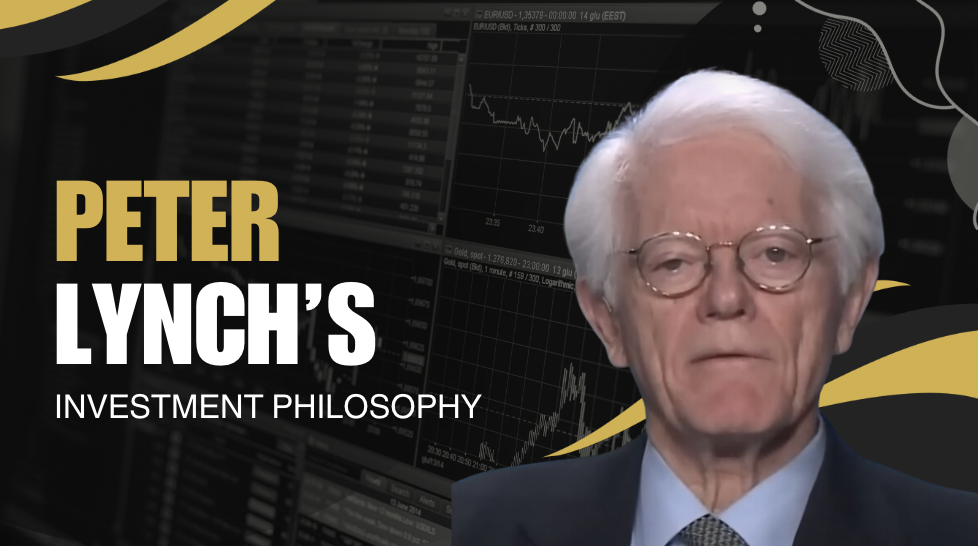Turning $1,000 into $28,000- Peter Lynch’s Investment Philosophy
Turning $1,000 into $28,000 in Just a Decade
Picture transforming a modest $1,000 into a staggering $28,000 in just over a decade. This isn’t a hypothetical scenario but the real-life achievement of Peter Lynch, the iconic manager of Fidelity’s Magellan Fund. From his early days as a caddy to becoming a celebrated investment guru, Lynch’s story is a powerful illustration of value investing’s potential.
In this exploration, we’ll decode the strategies behind Lynch’s remarkable wealth generation, offering actionable insights for investors aiming for financial triumph.
Takeaway: Discover the investment strategies and mindset that catapulted Peter Lynch to stock market stardom.
Key Takeaways from This Article
- Invest in What You Know: Leverage personal insights for informed and confident investment decisions.
- Seek Out Undervalued Companies: Identify and invest in stocks priced below their intrinsic value for substantial gains.
- The Quest for Exponential Growth: Aim for “tenbaggers” by spotting companies poised for significant growth.
- Utilize the PEG Ratio: Employ the PEG ratio to find undervalued growth stocks with high potential.
The Magellan Fund Miracle
Under Peter Lynch’s stewardship for 13 years, the Magellan Fund saw an average annual return of 29.2%, growing from $20 million to over $14 billion in assets.
Lynch’s strategy was simple yet profound: invest in well-understood, quality companies at reasonable prices.
His intuitive principle of “invest in what you know” led to profitable stakes in household names like McDonald’s and Lowe’s, laying the groundwork for his unparalleled success.
Unpacking Lynch’s Investment Wisdom
Peter Lynch’s approach to investing is encapsulated in four fundamental principles:
Invest in the Familiar
Championing the strategy of investing within one’s own sphere of knowledge, Peter Lynch underscores the significance of leveraging personal insights and experiences in the investment process.
This tactic advocates for a deep dive into sectors and companies where an investor’s understanding is strongest, enabling a more nuanced evaluation of investment opportunities.
Such a focused approach enhances the investor’s ability to discern both the potential rewards and risks, fostering a foundation for investment decisions that are not only well-informed but also poised for success.
Hunt for Undervalued Gems
At the heart of Lynch’s methodology is the meticulous search for companies that, despite possessing solid fundamentals and promising futures, are not fully appreciated by the market.
This strategy demands an exhaustive analysis of financial data and market trends to discover stocks that are undervalued relative to their actual worth.
Targeting these hidden jewels can lead to substantial returns as the broader market gradually comes to recognize their inherent value.
Quest for Tenbaggers
Central to Lynch’s philosophy is the relentless quest for “tenbaggers,” or investments that can potentially deliver a tenfold increase in value.
This approach is dedicated to identifying enterprises at the cusp of significant growth, often driven by novel products, services, or strategic directions.
Such a quest necessitates a vigilant approach to research, including a keen observation of the latest developments within industries and technological frontiers.
PEG Ratio Advantage
Lynch is renowned for promoting the Price/Earnings to Growth (PEG) ratio as a vital tool for pinpointing growth stocks that are undervalued by the market. He views a PEG ratio below 1 as indicative of an investment ripe with potential.
This metric serves as a crucial aid for investors in identifying companies whose stock prices have not yet caught up with their growth prospects, providing a systematic strategy for uncovering attractive investment opportunities.
The Lynch Mindset
Beyond his strategic acumen, Lynch’s success was significantly influenced by his mindset:
Patience and Vision: Lynch steered clear of market timing, concentrating instead on company fundamentals, confident that quality businesses would, in time, yield market rewards.
In-depth Research: Lynch’s commitment to thoroughly understanding his investments involved extensive research and direct engagement with companies, providing him with a comprehensive view of potential growth.
Diversification and Risk Management: Despite his success, Lynch never downplayed the importance of a balanced portfolio, which safeguarded his investments against market volatility.
Lynch’s Enduring Legacy
Post-retirement, Lynch continued to impact the investment world through his writings and educational endeavors.
His seminal works, “One Up on Wall Street” and “Beating the Street” have guided countless investors, cementing his status as a value investing luminary.
Lynch’s legacy lives on, inspiring investors to embrace fundamental analysis, patience, and a thorough understanding of their investment choices.
Conclusion
Peter Lynch’s journey from a humble beginning to a celebrated investor underscores the efficacy of value investing.
By adhering to Lynch’s principles of informed investing, seeking value, and maintaining a disciplined approach, investors can navigate the stock market’s complexities toward achieving their financial goals.
While the market offers no certainties, Lynch’s methodologies provide a robust framework for aspiring to investment success.





